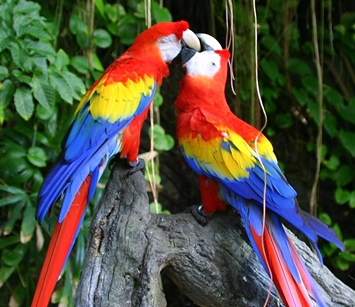
Scarlet macaw(Ara macao)
Phylum —chordata
Class — aves
Order — psittaciformes
Family — psittacidae
Genus – ara
Appearance
The two subspecies can be recognized by size and color detail in the feathers on the wings:
- A. m. Macao: South American Scarlet macaw, the nominate subspecies. In the wings the medium and secondary coverts have green tip.
- A. m. Cyanopterus: North Central American Scarlet macaw. The Central American Scarlet macaw is larger and has blue on its wings instead of green.
It is about 81 centimeters (32 in) long, of which more than half is the pointed, graduated tail typical of all macaws, though the Scarlet macaw has a larger percentage of tail than the other large macaws. The average weight is about 1 kilogram (2.2 lb). The plumage is mostly scarlet, but the rump and tail-covert feathers are light blue, the greater upper wing coverts are yellow, the upper sides of the flight feathers of the wings are dark blue as are the ends of the tail feathers, and the undersides of the wing and tail flight feathers are dark red with metallic gold iridescence. Some individuals may have green in the wings.
There is bare white skin around the eye and from there to the bill. Tiny white feathers are contained on the face patch. The upper mandible is mostly pale horn in color and the lower is black. Juveniles have dark eyes; adults have light yellow eyes.
Habitat
This macaw is native to the humid evergreen forests of the American tropics in Central and South America, including Mexico in the east, Guatemala, Belize, Colombia, Ecuador, Brazil and Amazonian Peru.
Behavior
They are a diurnal species and flock as night approaches. In the morning they will often fly a long distance to find food, flying in small groups or pairs, often calling to each other in hoarse raucous voices. They make nests in tree hollows. If in their nest and danger presents itself, they will cautiously examine the scene until the danger has gone. If their nest is directly threatened, the birds quietly escape to a place of safety. Macaws often use their left foot when handling food and grasping other objects. They communicate by means of a range of postures and vocalizations.
Diet
Wild Scarlet macaws eat mostly nuts, fruits and seeds, some large, hard seeds amongst them. Sometimes they are seen eating clay at river banks. They now and again supplement their diet with flowers and nectar.
Reproduction
These birds are monogamous and they bond for life. Once they have formed a pair, they are hardly ever seen alone, except to feed while the other bird incubates the eggs. Mates show affection by mutual preening and licking each other's faces. About every one or two years breeding occurs. 2 to 4 rounded, white eggs are laid, and are incubated for around 24 to 25 days. It is mainly the females which incubate the eggs. The young stay with the adults for up to one to two years. Males and females both care for the chicks. The parents do not raise another clutch until the first chicks have become independent. Macaws are sexually mature by 3 or 4 years old.
In captivity
The Scarlet macaw can live up to 75 or even 90 years in captivity, although a more typical lifespan is 40 to 50 years.
A Scarlet macaw is best suited for a large space and will not thrive in a cage that is too small. Get a cage that is at least 2 1/2 feet by 3 feet. It needs a lot of out-of-cage time, and if it doesn't get it, the bird may develop behavioral problems. It will resort to feather-plucking and other forms of self-mutilation. They can get bored quite easily, so provide them with large swings and toys.
Once a week, offer your macaw a bath or hose down your bird with lukewarm water using the fine-mist setting of your handheld shower sprayer.
To prevent your bird from flying through an open window or door, trim its primary wing feathers.
The best diet for a macaw in captivity begins with a formulated parrot mix that includes a variety of seeds, dried fruits, and nuts. Provide a variety of fresh fruits and vegetables daily, as well as high-calcium greens like kale and spinach. An all-seed diet is extremely unhealthy for these birds. Never offer chocolate and avocado, which are toxic.
The average healthy macaw will consume approximately 10 to 15 percent of its body weight daily. An average bird weighs about 2 pounds. You can expect a bird will eat about 1/2 cup of food per day, which equates to about 100 pounds of food per year. Feed them in the morning upon waking. Remove any uneaten chop or freshly cut fruits and vegetables after an hour.
Macaws are large birds and need ample space and time to play and stretch their muscles. These are active birds by nature. These birds need the means to burn off energy. A Scarlet macaw should be allowed outside of the cage for at least two hours a day; five hours is optimal.
Rotate a varied supply of chew toys to help it exercise its powerful beak and jaws. Rugged toys that can take a beating help the jaw muscles while providing an outlet for the chewing instinct.
A play gym or a parrot cargo net that allows your macaw to play and climb can be a great activity to help your bird meet its exercise requirements.
 Russian
Russian
 English
English























